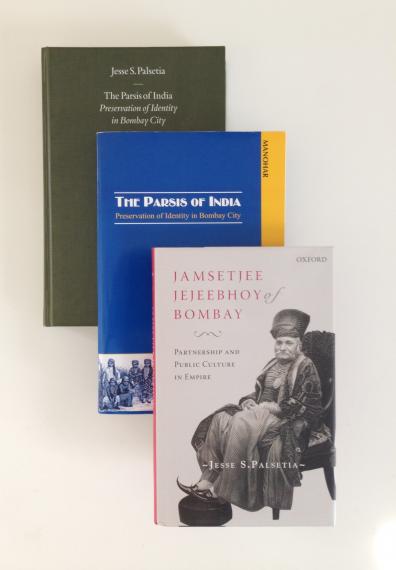Jesse Palsetia

Education
Ph.D. University of Toronto, 1996
M.A. University of Toronto, 1989
B.A. University of Toronto, 1987
Professional
Visiting Assistant Professor, University of Toronto at Mississauga, 2001–2002
Research Scholar and Associate, Centre for South Asian Studies, University of Toronto, 1997–2002
Area of Research
British Imperialism
Parsis (Zoroastrians) of India
South Asia
British Empire
Books
Jamsetjee Jejeebhoy of Bombay: Partnership and Public Culture in Empire New Delhi: Oxford University Press, India, 2015.
The Parsis of India: Preservation of Identity in Bombay City. Leiden: Brill, 2001; reprint, New Delhi: Manohar Publications, 2008.
with N.K. Wagle, Rights and Privileges: Fifty Years of the Indian Constitution, South Asian Studies, no. 15. Toronto: University of Toronto, Centre for South Asian Studies, 2003.
Articles
“Bombay Lights: Gas Light and the Transition to the Modern City,” South Asia Research, Volume 43, Issue 3 (2023): 257–75.
“Parsi and Hindu Traditional and Nontraditional Responses to Christian Conversion in Bombay, 1839–45,” Journal of the American Academy of Religion 74, No. 3 (September 2006): 615–45.
“Merchant Charity and Public Identity Formation in Colonial India: The Case of Jamsetjee Jejeebhoy,” Journal of Asian and African Studies 40, No. 3 (June 2005): 197–217.
“‘Honourable Machinations’: The Jamsetjee Jejeebhoy Baronetcy and the Indian Response to the Honours System in India,” South Asia Research 23, No. 1 (May 2003): 55–76.
“Mad Dogs and Parsis: The Bombay Dog Riots of 1832,” Journal of the Royal Asiatic Society, series 3, Vol. 11, No. 1 (April 2001): 13–30.
Book Chapters
“Three Zoroastrian Travellers in England: Parsi Travel in the Age of Empire,” in Alberto Cantera, Maria Macuch and Nicholas Sims-Williams, eds. Iranica 30: The Reward of the Righteous: Festschrift in Honour of Almut Hintze. Wiesbaden: Harrassowitz Verlag, 2022, 371-84.
“Parsis and Bombay City: Community ad Identity in the Nineteenth Century,” in Prashant Kidambi, Manjiri Kamat and Rachel Dwyer, eds. Bombay Before Mumbai: Essays in Honour of Jim Masselos. London: Hurst and Co., 2019, 35–56.
“Zoroastrianism in India,” in Meenaz Kassam, ed. Religions of India: A Microcosm of World Religions. New Delhi: Manohar, 2017, 225–46.
“The Parsis of India: Rise, Prominence, and History,” in Shalini Bharat and Armaity S. Desai, eds. The Parsis of India Continuing at the Crossroads: Vol. 1, The Indian Parsis: Themes Old and Contemporary. New Delhi: Sage Publications, 2017.
“Parsi Charity: A Historical Perspective on Religion, Community, and Donor-Patron Relations Among the Parsis of India,” in Almut Hintze and Alan Williams, eds. Iranica 24, Holy Wealth: Accounting for This World and the Next in Religious Belief and Practice. Festschrift for John R. Hinnells. Wiesbaden: Harrassowitz Verlag, 2016, 175–92.
“The Parsis of Bombay and Christian Conversion,” in Elizabeth Koepping, ed. World Christianity, 3 vols. New York: Routledge, 2010, Vol. 2, Part 8.
“Parsi Dress and Identity,” in Shilpa Shah and Tulsi Vatsal, eds. Peonies and Pagodas: Embroidered Parsi Textiles Tapi Collection. Surat: Garden Silk Mills Ltd., 2010, 168–75.
“Partner in Empire: Jamsetjee Jejeebhoy and the Public Culture of Nineteenth Century Bombay,” in J.R. Hinnells and Alan Williams, eds. Parsis in India and the Diaspora. London: Routledge, 2007, 83–101.